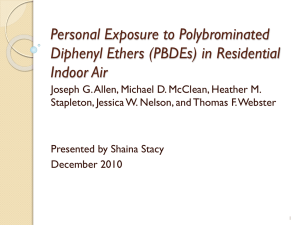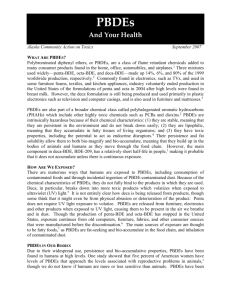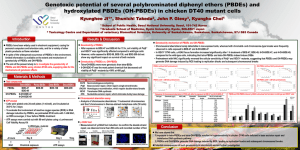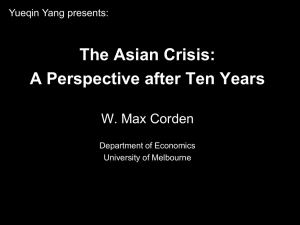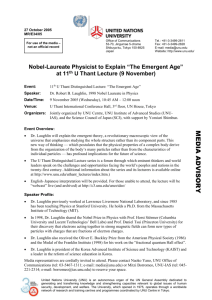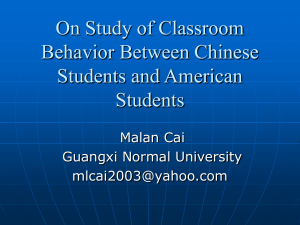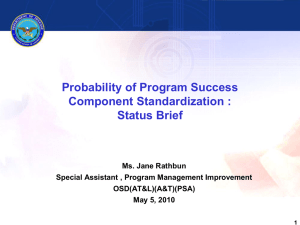Penta-BDE(BDE-99)
advertisement
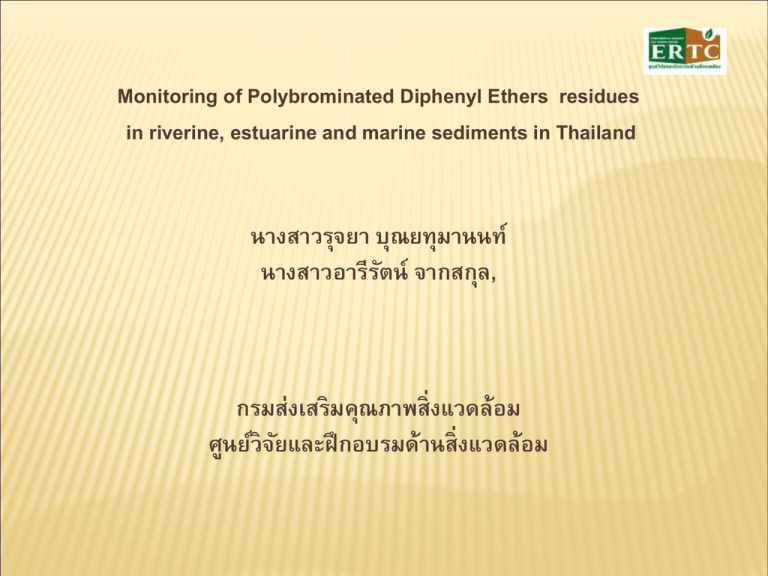
Monitoring of Polybrominated Diphenyl Ethers residues in riverine, estuarine and marine sediments in Thailand นางสาวรุจยา บุณยทุมานนท์ นางสาวอารีรตั น์ จากสกุล, กรมส่งเสริมคุณภาพสิ่งแวดล้อม ศูนย์วิจยั และฝึ กอบรมด้านสิ่งแวดล้อม OUTLINE What’s PBDE Objectives Sampling Location Method QA/QC result Result and discussion Conclusion Office equipment and household decoration electrical circuit monitor mat curtain sofa mattress Polybrominated diphenyl ether structure : 209 Commercial used octa-BDE196, 203, 197 Detected in environment penta-BDE 99, tetra-BDE 47 Breast milk : 27, 47, 99, 100, 153, 154, 183, 209 Daily PBDE dietary intake US population by age and food group (pg/kg body weight) Ref: Environmental Health Perspective 2006, october114(10), 1515-1520 • To assess the contamination of PBDE in riverine, estuarine, marine sediments from aquatic environment of Thailand • To support the data of pollutants residue to policy maker of Stockholm Convention, Thailand 4 3 2 9 10 11 1 TH TH MK N 12 CH 15 78 200 1 7 14 Petchaburi 0 BK BK 17-22 6 5 3,11 4 chonburi 9 400km Rayong RayongTrad 9 •Rayong province, sample NO. 6,8,16 (Industrial areas) •Chonburi province, sample NO.9 •Bang-Pakong river mouth, sample NO.1 •Chao-Phraya river mouth, sample NO.3, 11 •Tha-Chin river mouth, sample NO.15 •Mae-Klong river mouth, sample NO.14 •Petchaburi province, sample NO.7 •Trad province, sample NO.12 • Samutprakran province NO17-22 3 6,8,16 12 Sampling stations (coastal area and river mount) Analytical Method for Sediment/Soil Extraction HEX:ACE 1:1 Clean up spike Multilayer Silica gel Acid GPC Silica gel PBDEs HBCDs Cu Syringe spike injection GC-MSD (Mono-Hepta Agilent 5973 Octa-Deca JEOL GC Mate Ⅱ) LC-MS-MS (Waters MicroMass Quattro) PBDEs analysis in Laboratory PBDEs analysis in Laboratory PBDEs analysis in Laboratory PBDEs analysis in Laboratory PBDEs analysis in Laboratory PBDEs analysis in Laboratory Result and discussion Average Recovery and Recovery %RSD for IPR Compound Name Type Tri-BDE (BDE-028) Tetra-BDE (BDE-47) Penta-BDE (BDE-100) Penta-BDE (BDE-99) Native BDE Hexa-BDE (BDE-154) Hexa-BDE (BDE-153) Hepta-BDE (BDE-183) Deca-BDE (BDE-209) Average Recovery (%) 70 - 130% 6.928 15.531 4.819 16.558 7.066 10.880 3.009 5.207 Labeled BDE 94.524 119.938 130.112 114.466 128.600 152.640 159.198 77.903 > 70% 15.829 15.358 17.514 16.009 16.363 17.411 17.367 16.439 13C Hexa-BDE (BDE-139L) Cleanup Spike 143.387 > 70% 16.623 13C Tri-BDE (BDE-028L) 13C Tetra-BDE (BDE-47L) 13C Penta-BDE (BDE-100L) 13C Penta-BDE (BDE-99L) 13C Hexa-BDE (BDE-154L) 13C Hexa-BDE (BDE-153L) 13C Hepta-BDE (BDE-183L) 13C Deca-BDE (BDE-209L) 102.063 103.856 107.398 90.655 106.905 98.212 108.499 127.386 Average Recovery (%) Recovery %RSD Allowance Recovery %RSD Allowance < 20% Limit Of Quantitations (LOQs) Compound Name LOQ (ng/g) Tri-BDE(BDE-028) Tetra-BDE(BDE-47) Penta-BDE(BDE-100) Penta-BDE(BDE-99) Hexa-BDE(BDE-154) Hexa-BDE(BDE-153) Hepta-BDE(BDE-183) Deca-BDE(BDE-209) 0.308 0.183 0.117 0.122 0.456 0.316 0.177 18.12 Result and discussion The PBDEs concentration of each sediment samples was not detected although the sampling station was located surrounding the industrial area. For the remote areas the PBDEs concentration were also not detected with LOQs. Historical PBDE in Thailand, the country has never produce or import PBDE. After Thailand agree to banned the PBDE follow the Stockholm convention, Ministry of Natural Resources and Environment request to our research center (ERTC) start to monitor sediments from possible point source and remote area to supported data for Environmental Pollution Department , which is secretarial of the Stockholm convention Thailand. The data from UNU project used for supporting the convention. Thailand already set up The National Implementation Plan (NIP) for new POPs. Conclusion The United Nations University project produce fruitful technique and new data. And it can support the our environmental policy of Thailand, especially new POPs. Therefore, we hope that the UNU and Shimadzu can continue technical support for other new POPs. Acknowledgement I am very appreciate for all supports from Shimadzu for developing method of the PBDEs analysis in sediment and financial support the project from UNU. Lastly, I thanks for our staffs at ERTC to support UNU project, do analyse the sample and sampling. ………………………………… โครงการความร่ วมมือระหว่ างกรมส่ งเสริมคุณภาพสิ่ งแวดล้ อม และ The United Nations University (UNU) ความเป็ นมา ศูนย์วจิ ยั และฝึกอบรมด้านสิง่ แวดล้อมภายใต้กรมส่งเสริมคุณภาพสิง่ แวดล้อม กับ The United Nations University (UNU) เริม่ โครงการความร่วมมือตัง้ แต่ พ.ศ.2539 ถึงปจั จุบนั รวม11 ประเทศ คือ ญีป่ นุ่ อินโดนีเซีย ฟิลปิ ปินส์ สิงคโปร์ มาเลเซีย เกาหลี เวียดนาม ปากีสถาน จีน อินเดีย ไทย และความร่วมมือทีผ่ า่ นมาประเทศไทยได้รบั การถ่ายทอดเทคโนโลยีดา้ นการ วิเคราะห์สารทีต่ กค้างยาวนาน (Persistent Organic Pollutants, POP) หลายประเภท เช่น สาร ฆ่าแมลง สารพีซบี ี ในตัวอย่างสิง่ แวดล้อม เป็ นต้น Overview of Cooperative project with the United Nations University (UNU) First phase : 1999-2002 “Environmental Monitoring and and analysis in the East Asian Region Focus on : VOC, organotin compound Media: Air, soil Secound phase : 2003-2005 “Environmental Monitoring and Governance in the Asian Coastal Hydrosphere Monitoring of POPs in the Asian Region Focus on : POP : organichlorine pesticide, phenol, phathalate Media: water, sediment, fish Third phase : 2006-2008 “Environmental Monitoring and Governance in the Asian Coastal Hydrosphere Monitoring of POPs in the Asian Region Focus on : POPs , PCBs Media: water, sediment and biological tissue samples Fourth phase : 2010-2012 “Environmental Monitoring and Governance in the Asian Coastal Hydrosphere Monitoring of POPs in the Asian Region Focus on : POPs, PBDE Media: sediment Fifth phase : 2012-2013 “Environmental Monitoring and Governance in the Asian Coastal Hydrosphere Monitoring of POPs in the Asian Region Focus on : POPs , PFOS Media: sediment
